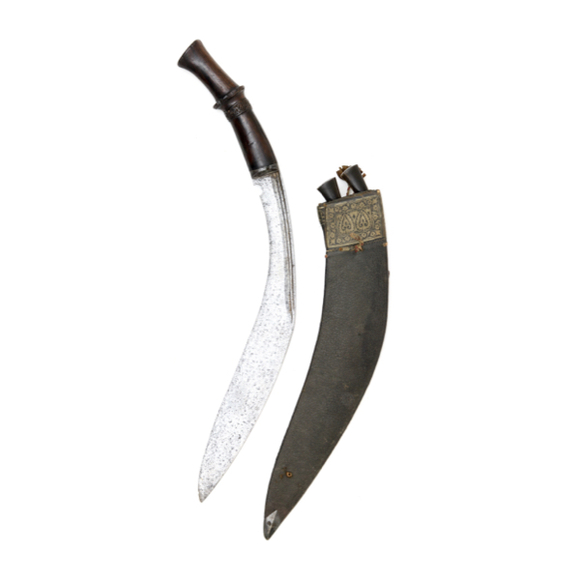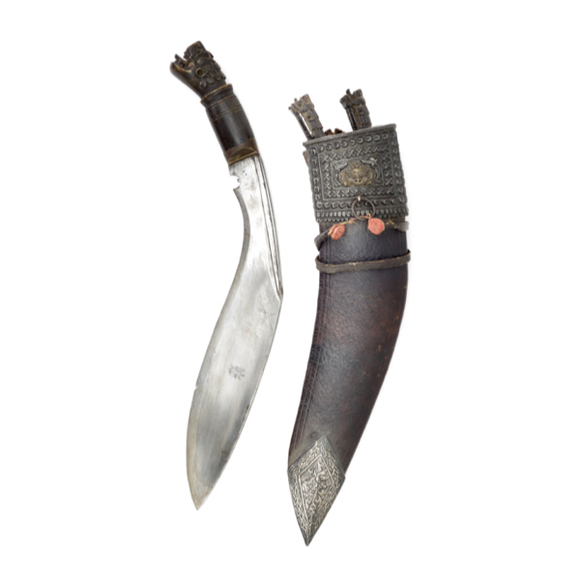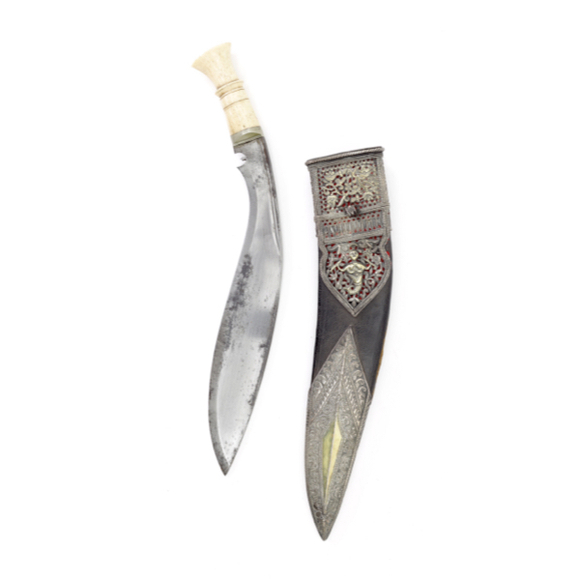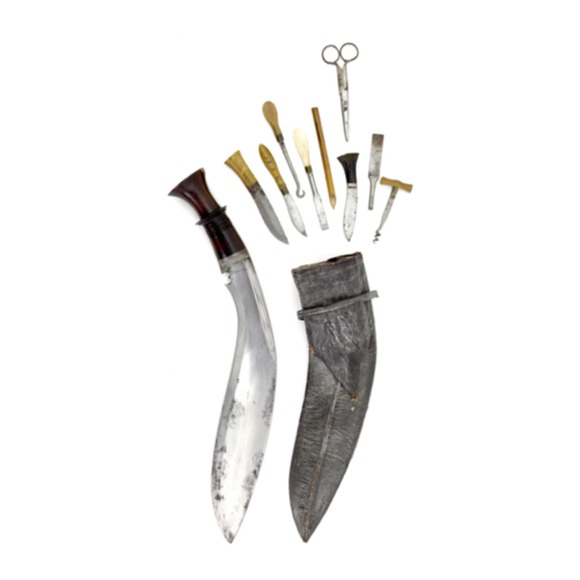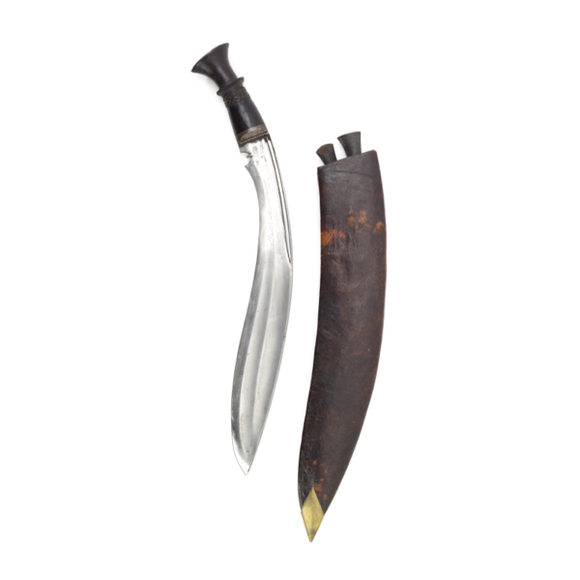Language: Dzongkha
Source: In common use
Description
The national sword of Bhutan, the patag has a straight, single-edged blade and was typically worn on the right hip. This is fairly unusual, most cultures around the world customarily wear a sword on the left hip so it is easy to grasp with the right hand. It was probably to convey the peaceful intent of the wearer during formal occasions.
Swords were worn in Bhutan by officials of the dasho "red scarf officer" and higher as a weapon and status symbol.1

"Group of Bhotanese, chiefly of Tibetan origin, Bhotan c1860s."
From: The people of India. J. Forbes Watson and John William Kaye.
London, India Museum, 1868.
Notes
1. Diana K. Myers & Susan S. Bean; From the Land of the Thunder Dragon; Textile Arts of Bhutan. London, Serindia Publication. Peabody Essex Museum, Salem. 1994. Page 123.
Blades
All Bhutanese patag have straight, Tibetan style blades with parallel or nearly parallel spine and edge, terminating in an oblique or sometimes rounded point. Most are forged in the Tibetan hairpin style, with laminations stacked from edge to spine, folded over near the tip to create the V patterns often seen there.
There are often longitudinal "forging flaws" are typical for Himalayan bladesmithing, where the lower levels of oxygen in the atmosphere made it harder to reach and maintain high temperatures in the forge. They are typically shallow and of no structural consequence and can be seen as a hallmark for proper Himalayan work. Whenever they do not appear, we are often looking at an imported blade.
The blades were often burnished to a mirror-like finish with the different layers stand out in slight relief.
Traditional Bhutanese sword polish
As described by Dr. Jagar Dorji, Intangible Cultural Heritage of Bhutan.1
The stained and newly forged swords are rubbed on a shobda (a hard white whetstone) to remove stains and other marks. Then it is rubbed with hide and soaked in water to remove stains and marks between grooves and narrow depressions created while forging. Thereafter it is rubbed on a dreyda (black gravel whet-stone), giving an ash-black color to the sword. A piece of hide is then then used to rub the sword in order to increase its lustre, the hide is filled with small fragments and scales of iron that fall off in the process of hammering of hot iron, called chagchey. It is further rubbed with green artemesia leaves and soot to remove dirt and patches created in earlier processes. Finally, it is rubbed with powdered charcoal of pinewood wrapped in a
piece of cloth, and with a soft and dry cloth to remove moisture from the sword.
Notes
1. Dr. Jagar Dorji, Intangible Cultural Heritage of Bhutan. Research & Media Division. National Library & Archives of Bhutan. Published auspices of UNESCO. Page 225. (Available online.) The article uses "cast" throughout the text but this is probably a mistake in translation, as these swords are surely forged.
Scabbard types
A description of main scabbard types, by Dr. Jagar Dorji, Intangible Cultural Heritage of Bhutan.1
Churi chemn
The highest-class Bhutanese scabbard. It is entirely clad in silver, consisting of three main sections. The middle section is decorated in repousse with a triple W pattern called churi, which is a stylized representation of flowing rivers. All decoration is parcel gilt. Worn by kings. In the old days, it was worn by the main advisor of the king, called changap. Later also by other senior officials.
 A classic churi-chenm.
A classic churi-chenm.
Sold by Mandarin Mansion in 2017.
Ben chang
Much like the above but without the churi pattern. Worn by the zimpon (chamberlain), changap (advisor to the king), and other royal attendants. See for example Victoria & Albert Museum accession number IS.3&A-1965.
Belpa chen
Like ben chang but now the middle section is covered with what is called frog (belpa) skin. According to a poem, it was worn by Pemi Tshewang Tashi, Chamberlain to Dzongpon Angdruk Nim when going to the battle of Changmanyik, 1876.
Konag chenm and sernag chenm
Similar to belpa chenm, but using different hide. On extant examples, various types of leather and sometimes ray-skin are seen. Worn by elderly officials.
Hoshu chenm
This scabbard is covered with red felt on the upper section, green felt on the middle section, and the last section is silver like the previous examples. There is a golden decorated band at the scabbard mouthpiece and a band of parcel-gilt repousse work on the upper side of the silver endpiece. Worn by senior officials and elderly men.
One such sword was carried by Chimi Dorji, the Jakar Dzongpön (governor of Bumthang) who signed the oath of allegiance to King Ugyen Wangchuck at his 1907 coronation. It bears a tag saying kongdi maja, supposedly the name of the sword. Now in the collection of his granddaughter, Mrs. Ugen Norzom Namgyel.2
Zhangshi chenm
Brass covered scabbard without decoration. (Zhang means bronze.)
Traditionally worn by ardung and the lower rank attendants of the king.
Despite some scabbards being commonly worn by certain classes, there was no rigid requirement for a particular sword to be worn inside a particular scabbard. It depended on one's wealth and affordability, and some were simply passed down.
Notes
1. Dr. Jagar Dorji, Intangible Cultural Heritage of Bhutan. Research & Media Division. National Library & Archives of Bhutan. Published auspices of UNESCO. Page 225. (Available online.)
2. Diana K. Myers & Susan S. Bean; From the Land of the Thunder Dragon; Textile Arts of Bhutan. London, Serindia Publication. Peabody Essex Museum, Salem. 1994. Page 123.


